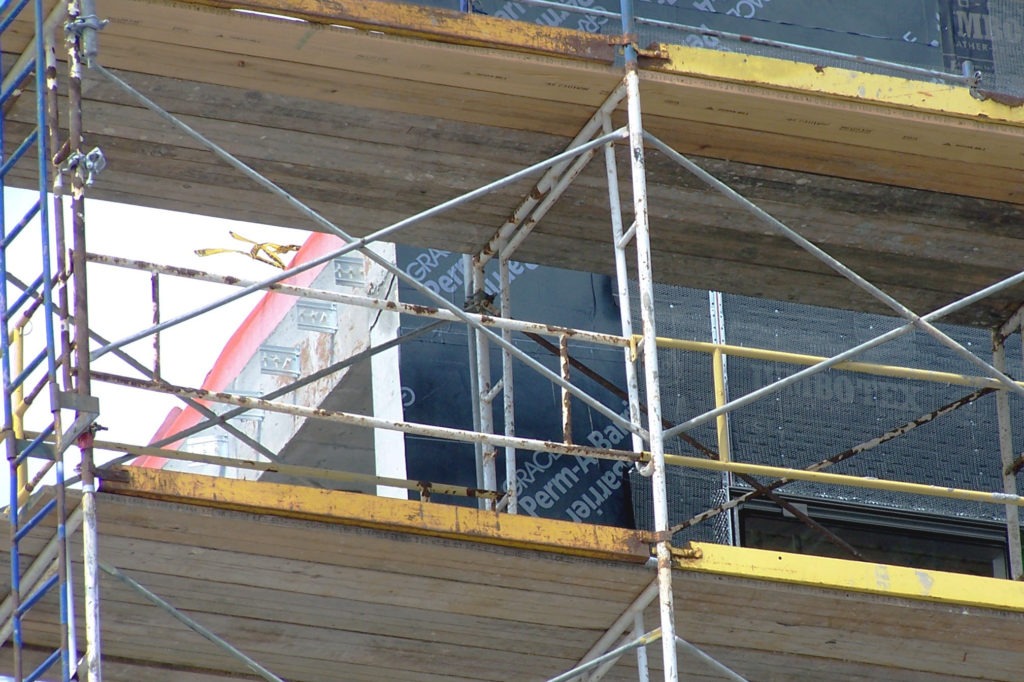Inspector Plank: Do Your Scaffold Planks Meet The Mark?
Words: Michael Alley
Words and Photos: Michael Alley, CFA and Finance Director at INDIAN MILL PLANK
Do you know your wood scaffold plank? What is the condition of your scaffold planks? When should you retire them? Do not wait until a scaffold plank breaks to evaluate your plank inventory. What is OSHA looking for at a job site inspection? Will your scaffold plank meet the mark?
 Chemically Exposed Board
Chemically Exposed BoardWood will degrade over time with exposure to weather, job site materials, and use. Much like us, wood is made up of cells, which string together to form the wood fibers. When the wood fibers begin to break down, strength is reduced. An inspector may look for planks that have been altered, severely discolored or warped. Altered boards would include modifications such as drill holes or saw cuts. Severely discolored boards might indicate chemical exposure or rot. Warped boards are potential tripping hazards. But be aware boards may have unseen issues. Does the board feel abnormally light? There is a chance for interior rot. Is the board abnormally heavy? The board may be waterlogged, which may lead to future issues as the water dries and causes the lumber cells to shrink. Waterlogged planks may bend excessively. Regular plank inspection is a good practice and could prevent a plank failure that results in an injury or worse.
OSHA does not define the standards for wood scaffold plank, but they create requirements and guidelines expected of wood scaffold plank. Specifically, this requirement relates to OSHA Section 1926.451(f)(16), which specifies that platforms may not deflect more than 1/60 of the span when loaded. This rule would imply that an eight-foot span cannot deflect more than 1.6 inches. However, American Lumber Standards sets forth the grading requirements for solid sawn wood scaffold plank to meet this requirement.
According to the OSHA Guide to Scaffold Use in the Construction Industry, platforms and planks must meet intended load guidelines. These are outlined in the following table.
OSHA Scaffold Load Table – Appendix A 1(c)
| Rated Load Capacity | Intended Load |
| Light-duty | 25 lbs per sq ft applied uniformly over the entire span |
| Medium-duty | 50 lbs per sq ft applied uniformly over the entire span |
| Heavy-duty | 75 lbs per sq ft applied uniformly over the entire span |
| One-person | 250 lbs placed at the center of the span (total 250 lbs) |
| Two-person | 250 lbs placed 18” to the left and right of the center of the span (total 500 lbs) |
| Three-person | 250 lbs placed at the center and 250 lbs placed 18” to the left and right of the center of the span (total 750 lbs) |
A significant portion of the wood scaffold plank market uses Southern Yellow Pine; however, Douglas Fir is used in some geographies. Wood scaffold plank is extremely high-grade dimensional lumber, most commonly found in the nominal size of 2x10 and 2x12. Nominal sizes do not equate to the actual size. For example, an industry-standard 2x10 is actually only 1 ½” by 9 ¼”, and a 2x12 is 1 ½” by 11 ¼”. In extremely rare cases, lumber mills will produce scaffold plank at full dimensions. Given the cost of changing the mill standard cuts, full-dimension lumber is expensive and hard to find. Nominal dimensional lumber has been in place since 1964.
Inspecting scaffold planks to meet OSHA guidelines requires a visual inspection of the scaffold plank condition and the periodic evaluation of the plank's ability to meet the intended load. Indian Mill has created a center load scaffold plank tester that will test a plank’s ability to meet the deflection requirement. The tester is called the SPT-6 scaffold plank tester, which can be rented or bought, or Indian Mill can provide inspection and testing services.
 SPT-6 Scaffold Plank Tester
SPT-6 Scaffold Plank Tester
In regards to visual plank inspection, please see the Masonry Magazine article "Understanding Board Wear And How To Prevent It". This article specifically outlines some of the key board wear and tear and when certain issues must be addressed through board retirement or remedial action.

Certain things may be done to extend the board’s life, including using clear drying coatings to reduce the impact of water, sun and chemical exposure. OSHA requires a clear drying coat as the board’s lumber stamp and/or markings must remain visible. Indian Mill produces a standard scaffold plank product in Dense Industrial 65, a wood grade that is expected to meet or exceed OSHA standards. Other scaffold plank grades include MSR (Machine Stress Rated) 2200 and MSR 2400. Dense Industrial 65, MSR 2200 and MSR 2400 are generally considered the minimum scaffold plank standard. The lumber grade is based on visual characteristics and board density based on lumber growth rings. Indian Mill produces proprietary engineered wood scaffold planks that have improved load characteristics versus solid sawn scaffold planks. This product is the Pin-Lok 2.0E scaffold plank that follows the same actual dimensions as a nominal 2x10.
For additional inspection and testing questions, please reach out to Patrick Gajewski at Indian Mill or visit the website at www.indianmill.com.